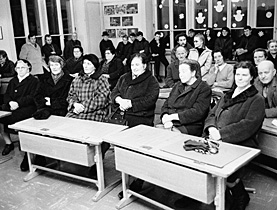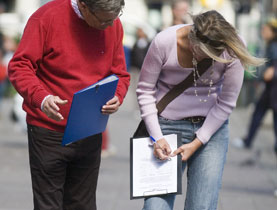Switzerland: a country of politicians

With 2,636 communes, 26 cantons and a federal tier of government, Switzerland very probably has the densest concentration of "politicians" in the world.
But some posts remain unfilled, as Switzerland’s system of grass-roots democracy is suffering from a shortage of volunteers.
Why “very probably”? Because Switzerland, organised on federal lines, does not keep centralised statistics in this field. As for statistics in other parts of the world….
It is, however, established that Switzerland’s resident population of 7.7 million is spread over 2,636 communes, giving an average of 2,921 inhabitants per commune. In Europe, only France has proportionally more communes (with an average of only 1,800 inhabitants).
Elsewhere, the parish-based territorial system has been “modernised”, and non-urban communes often cover vast rural areas comprising a number of villages.
Tiers of government
In Switzerland, every commune has at least three elected representatives (and sometimes as many as 15), who make up the local executive. This executive body, whose name varies from canton to canton (commune council, town council, administrative council), must have its decisions approved by a “parliament” (also generally referred to as a “council”), be it commune or general.
These local councils are supported by a number of committees (as many as ten in larger communes), which have responsibility for schools, the cemetery, town planning and so on. Their members are generally elected.
However, not all communes have an elected legislative body. Nationwide, this is the exception rather than the rule: in four cases out of five, it is the entire population which acts as the “parliament”.
And it is not always a matter of size. Although the French-speaking cantons generally favour representative democracy, and even communes with only a few hundred inhabitants elect a council, German-speaking Switzerland and the canton of Valais are still very much attached to direct democracy. For instance, in canton Zurich there are ten towns of over 10,000 inhabitants where legislative power is in the hands of the popular assembly.
Swiss people are citizens of both their commune and their canton. The 26 cantons making up the Confederation each has its own constitution, laws, government (five or seven members) and parliament (of between 46 and 200 deputies), elected by the people.
Interestingly, two cantons (Appenzell Inner Rhodes and Glarus) have retained the tradition of Landsgemeinde, an assembly of all the citizens, which meets once a year in the square of the chief town to ratify major decisions taken by the government and parliament.
Finally, Switzerland has a two-chamber Federal Parliament (200 and 46 members).
Who wants to be mayor?
This means that some 150,000 people hold elected office, generally on a part-time basis and for very little remuneration – and this in a country where the political parties together have only around 300,000 card-carrying members.
“This does not mean that belonging to a party automatically gives you a fifty-fifty chance of being elected,” explained Andreas Ladner, expert on politics at the Swiss Graduate School of Public Administration in Lausanne and author of these estimates. At commune level, roughly half the elected representatives have no party affiliation.
And it is becoming increasingly difficult to persuade people to stand as candidates and remain in office. At the beginning of the year, the government of canton Vaud had to appoint a provisional administration for the commune of Gressy (160 inhabitants), where four members of the executive had stood down.
And this case is by no means exceptional. In smaller communes, public office requires a real sense of mission. Councillors are paid a mere pittance – just a few thousand francs a year, equivalent to a case or two of wine – and in some communes nothing at all.
“We carry out regular surveys and for 20 years now the communes have been complaining that people are reluctant to get involved and work for the common good,” observed Ladner.
The problem is that the days when the weekly council meeting would end in a game of cards and a few drinks at the local pub are long gone. Nowadays, the tasks performed by elected representatives are more burdensome, complex and technical. And at the same time, the communes are losing their room for independent manoeuvre.
Voluntary mergers
Communes would therefore do better to merge and so gain in critical mass. The problem – notes Ladner – is that, “when you have a commune of two or three thousand inhabitants, the burden of work is much heavier and people will not necessarily want to commit themselves”.
That is why even larger mergers are now being discussed: not two small communes getting together to form a slightly larger one, but a whole valley, like the Val de Travers in the mountains of Neuchâtel. Here, nine communes have joined to form one, with 11,000 inhabitants. Even more spectacular are developments in canton Glarus: by 2011, the canton will have just three communes, where formerly there were 25.
In Switzerland, a country that has never been a monarchy and refused to accept the “one and indivisible” republic that Napoleon wanted to foist upon it, the communes and cantons have retained a predominant role.
“And the central government simply lacks the means to undertake a territorial reorganisation of the kind introduced in other countries,” pointed out Ladner.
This is therefore the task of the cantons. Or the communes, if they want to take it on.
Marc-André Miserez, swissinfo.ch (Translated from French)
At the creation of the federal state in 1848, Switzerland had 3,205 communes or municipalities. This number increased to 3,164 en 1900, 3,101 in 1950, 2,955 in 1990 and 2,636 in 2009.
Since 2008, 79 communes have disappeared, merged into bigger units – the greatest loss since 1848.
1,300 communes have fewer than 1,000 inhabitants.
1,028 others have fewer than 5,000.
105 communes have more than 10,000 inhabitants and comprise around one half of the Swiss population.
Least populated commune: Corippo (Ticino), 17 inhabitants
Most populated commune: Zurich, 345,000 inhabitants
Smallest commune: Ponte Tresa (Tessin), 28 hectares
Biggest commune: Davos (Graubünden), which merged with Wiesen on January 1, 2009, 28,300 hectares
Smallest: Basel-Country 37 km2, 5,000 inhabitants/km2
Biggest: Graubünden 7,105 km2, 27 inhabitants/km2
Least populated: Appenzell Inner Rhodes, 15,500 inhabitants
Most populated: Zurich, 1,307,600 inhabitants
According to a joint study by the universities of Zurich, Bern and Lausanne, nearly half the elected office holders in Swiss communes are independents.
In communes with a population of less than 1,000, there are now practically no representatives of the traditional parties.
Zurich sociologist Urs Meuli says the problems of local parties go back to the 1980s.
Before then, holding local political office was often a springboard for a person’s career.
Now people are more mobile and depend more on themselves.

In compliance with the JTI standards
More: SWI swissinfo.ch certified by the Journalism Trust Initiative














You can find an overview of ongoing debates with our journalists here . Please join us!
If you want to start a conversation about a topic raised in this article or want to report factual errors, email us at english@swissinfo.ch.